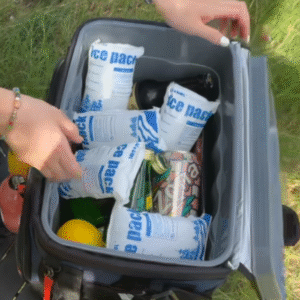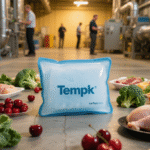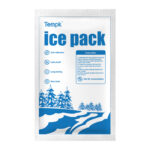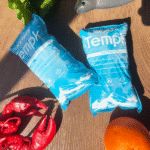Dry Ice Pack and Dry Ice Bricks Shipping: Optimizing Cold Chain Logistics in 2025
In today’s cold chain logistics, maintaining optimal temperatures is essential when shipping perishable goods such as seafood, carnes, productos farmaceuticos, y vacunas. hielo seco, in the form of either dry ice packs or dry ice bricks, provides an efficient and effective cooling solution for long-distance shipments. This article delves into the differences, beneficios, and best practices for shipping with dry ice packs and bricks in 2025, focusing on maximizing efficiency and compliance with evolving regulations.
-
Cuáles son paquetes de hielo seco and dry ice bricks, y como funcionan?
-
How do you calculate the right amount of dry ice for your shipment?
-
What are the best practices for shipping perishable goods using dry ice?
-
What safety measures must you follow when shipping with dry ice?
-
How do dry ice bricks compare to gel packs and other refrigerants?
What are Dry Ice Packs and Dry Ice Bricks?
El hielo seco es dióxido de carbono sólido (Co₂) that sublimates at an extremely low temperature of -78.5°C (-109.3°F). It is used to maintain frozen and chilled conditions for temperature-sensitive goods during transport. Dry ice packs and dry ice bricks, while both effective in cooling, serve different purposes depending on the shipping requirements.
Paquetes de hielo seco
Dry ice packs are flexible, lightweight sheets that are often used for small to medium-sized shipments. They are typically filled with small pellets of dry ice and encased in materials like plastic or foam. Dry ice packs are ideal for short-duration shipping and can be easily arranged in packaging to fit various sizes.
Dry Ice Bricks
Ladrillos de hielo secos, por otro lado, are large blocks of dry ice that offer a more concentrated cooling effect. These are ideal for longer shipments, providing extended cooling durations. The rigid form of dry ice bricks allows for more stable temperature control during longer journeys.
| Type of Dry Ice | Descripción | Caso de uso ideal |
|---|---|---|
| Paquetes de hielo seco | Flexible, lightweight sheets | Small to medium shipments requiring flexibility |
| Dry Ice Bricks | Rigid blocks, sublimación más lenta | Large shipments requiring extended cooling |
How Do Dry Ice Packs and Dry Ice Bricks Maintain Cold Temperatures During Shipping?
Dry ice achieves its cooling power through sublimation, where it transitions from solid to gas without becoming liquid. This process absorbs heat, effectively lowering the surrounding temperature.
Sublimation Process and Cooling
-
Paquetes de hielo seco: Sublimate at -78.5°C, providing moderate cooling for 24 a 48 horas. Their flexibility allows them to be easily distributed throughout the shipping container, maintaining consistent cold temperatures for smaller shipments.
-
Dry Ice Bricks: Sublimate at the same temperature, but their larger mass and solid form cause them to release CO₂ gas at a slower rate, allowing them to maintain cold temperatures for longer, making them ideal for shipments lasting up to 72 horas o más.
| Tipo de hielo seco | Ideal Duration of Use | Ideal Shipment Type |
|---|---|---|
| Paquetes de hielo seco | 24-48 horas | Short-distance shipments, bienes perecederos |
| Dry Ice Bricks | 72 horas o más | Long-distance shipments, bulk products |
Las mejores prácticas para usar hielo seco en el envío
Embalaje adecuado
-
Aislamiento: Use high-quality insulated boxes like Styrofoam or polyurethane foam to reduce heat transfer. Ensure the packaging allows for CO₂ gas to escape, as dry ice sublimates into gas.
-
Desfogue: Dry ice must be packed in containers that allow the CO₂ gas to vent to avoid pressure buildup, which could lead to the rupture of packaging.
Calculating the Right Amount of Dry Ice
The quantity of dry ice required depends on factors such as the shipment’s duration, la calidad del aislamiento, and the ambient temperature during transport. Como regla general, for a 24-hour shipment, 0.5 kg of dry ice per kg of the product should be used. Para duraciones más largas, increase the amount of dry ice by 1.5 times to account for sublimation rates.
Etiquetado y Documentación
Cuando se envía con hielo seco, it’s crucial to comply with regulatory requirements:
-
Proper labeling with “Dry Ice” or “Carbon Dioxide, Sólido"
-
UN1845 shipping number
-
Clase 9 etiqueta de peligro
-
The net weight of dry ice in kilograms
These labeling requirements are essential for ensuring safe and compliant transport.
Safety and Regulatory Compliance for Dry Ice Shipping
El hielo seco se clasifica como un material peligroso (Clase 9, UN1845) and requires adherence to specific shipping regulations. Compliance with IATA (Asociación Internacional de Transporte Aéreo) y punto (Departamento de Transporte) guidelines is mandatory to ensure safe shipping.
Key Compliance Requirements:
-
Embalaje: Dry ice must be transported in vented packaging, such as corrugated cardboard boxes with foam insulation.
-
Documentación: Include a proper air waybill with the shipping details, including the weight of dry ice.
-
Manejo: Always wear insulated gloves and safety goggles when handling dry ice to prevent injury from frostbite or eye exposure.
Hielo seco vs. Paquetes de gel: Which Is Better for Your Shipment?
Dry ice is often compared to gel packs, especially for shipments that need to be chilled but not frozen. Sin embargo, dry ice has several advantages for specific needs:
Hielo seco
-
Temperaturas extremadamente bajas: Dry ice can keep frozen goods solid, unlike gel packs, which are not designed for subzero temperatures.
-
Duración más larga: Ladrillos de hielo secos, En particular, provide longer cooling durations than gel packs.
Paquetes de gel
-
Safer and Easier to Handle: Los paquetes de gel no son tóxicos, reutilizable, and require no special handling. Sin embargo, they cannot achieve the ultra-low temperatures necessary for frozen goods.
-
Shorter Cooling Period: Gel packs are ideal for chilled items but not suitable for extended freezing.
| Método de enfriamiento | Caso de uso ideal | Ventajas | Contras |
|---|---|---|---|
| Hielo seco | Alimentos congelados, biológicos | Temperaturas ultra bajas, long duration | Requiere un manejo especial, cumplimiento regulatorio |
| Paquetes de gel | Productos frescos, meals | Más seguro, reutilizable, no tóxico | Rango de temperatura limitado, duración más corta |
Environmental Impact and Sustainability of Dry Ice Shipping
En 2025, sustainability is a key concern in the cold chain logistics industry. Dry ice offers some environmental advantages but also has its drawbacks.
Pros of Dry Ice:
-
Reclaimed CO₂: Many suppliers produce dry ice from CO₂ captured during industrial processes, Reducción de emisiones.
-
No Water Waste: Dry ice sublimates directly into gas, leaving no water residue and reducing waste.
Desafíos:
-
CO₂ Release: Although CO₂ is reclaimed, it is released into the atmosphere during sublimation.
-
Energy Use: The production of dry ice requires energy, typically from non-renewable sources.
Sustainability trends include the use of biodegradable refrigerants, IoT-enabled temperature monitoring, and smart packaging solutions.
Preguntas frecuentes (Preguntas frecuentes)
Q1: ¿Cuánto dura el hielo seco durante el envío??
El hielo seco generalmente dura entre 18 a 72 horas, Dependiendo del tipo (pack or brick), aislamiento, y condiciones ambientales.
Q2: ¿Se puede utilizar hielo seco para envíos internacionales??
Sí, El hielo seco se puede enviar internacionalmente., but it must comply with international shipping regulations, including those set by IATA and DOT.
Q3: What are the safety precautions for shipping with dry ice?
Asegurar una ventilación adecuada, use appropriate protective gear, and comply with all labeling and documentation requirements.
Conclusión y recomendaciones
Dry ice packs and dry ice bricks are vital for cold chain logistics, offering solutions for different shipment sizes, duraciones, y requisitos de temperatura. By understanding the differences between these options, calculating the appropriate amount of dry ice, and adhering to safety and regulatory guidelines, businesses can ensure the safe and efficient transport of temperature-sensitive goods.
Siguientes pasos:
-
Consulta con expertos to choose the right dry ice solution.
-
Invest in high-quality packaging Para mejorar el control de la temperatura.
-
Stay updated on regulations and sustainability trends to improve your cold chain logistics.
Acerca de Tempk
Y tempk, we specialize in providing cutting-edge cold chain logistics solutions, including dry ice packs and bricks. Our products ensure your goods remain safe and fresh during transport, with a focus on sustainability and regulatory compliance.
Llamado a la acción: Contact Tempk today to discuss how our dry ice solutions can enhance your logistics operations.
























